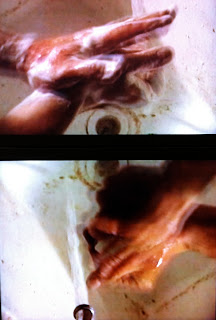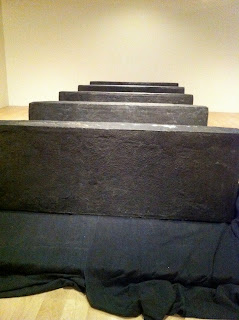"A Woman and her Maid in a courtyard"
By Pieter de Hooch, C. 1660
DIRT
The Filthy Reality of Everyday Life
Wellcome Collection (London)
24 March - 31 August 2011
The Wellcome collection is showing an overwhelmingly strong exhibit about DIRT. How we surround ourselves with dirt, our reactions to dirt, provocations, fear or disgusts. Also magical factors like growth in soil or creations from clay, antibiotics out of sewage...
"There is no such thing as absolute dirt: it exists in the eye of the beholder."
Mary Douglas (Purity and Danger: An analysis of concepts of pollution and taboo" 1966.
The exhibit is divided into six parts of urban locations, to show us how Dirt represents a significant threat to our health but also that it is vital to our existence.
1) The Home (Delft 1683 -)
Showing how the the people of the Netherlands put a lot of effort into cleanliness at an early time, and how it was represented in their Art. Delft was the center of ceramics industry and it was well used in the kitchen and on floors, it kept a spotless look.
Plate showing an interior with a woman sewing
1650-1700 Ceramic. Delftware
2) The Street (London, 1854-)
From the horror of Cholera that was spreading through polluted water and the cleaning up of London´s streets and Homes.
A young Venetian woman aged 23, depicted before and after contracting cholera
c.1831
Coloured stipple engraving.
"One 19th Century English newspaper report describes cholera victims who were one minute warm, palpating, human organism - the next a sort of galvanized corpse, with icy breath stopped pulse and blood congealed - blue, shrivelled up, convulsed. Cholera causes profuse vomiting and diarrhoea, dehydrating the body so rapidly and severely that the blood thickens and the skin becomes deathlike and blue." - Wellcome Library
A monster soup commonly called Thames water
William Heath 1828
John Bull
The Brick - keepers Dance, Crossness Pumping Station
"Laid to Rest" by Serena Korda
Dance, video
3) The Hospital (Glasgow 1867 -)
How Joseph Lister changed Glasgow Infirmary from a highly deathly institution to an economic success story. Lister did this by introducing an antiseptic surgery, that improved the sanitation system in an overcrowded city.
Diorama of the Lister Ward at the Glasgow Royal Infirmary
©Wellcome collection
Raw material washing hands (1996)
Bruce Nauman (Video)
Air balloon advertising Odol mouthwash c.1920
4) The Museum (Dresden 1930 -)
In 1911 Dresden held the first International Hygiene Exhibition and over 5 million visitors came. A success for Hygiene but also used by the ruling Nazi party and its racist ideologies. Hygiene now encompassed the science of racial hygiene, which taught that impure genes must be eradicated in order to create a physical and intellectual superior race.
Jews being forced to scrub the pavements of Vienna (1938)
5) The Community (New Delhi and Kolkata, 2011)
Showing how the Dalits (the broken people, formerly known as the untouchables) are paid a pittance to clear human waste often with hands. Over one million people is said to still do this even after the Government has tried to outlaw the "Manual Scavenging".
Savitri (age 30) a Dalit woman working as a manual scavenger,
Uttar Pradesh, India, 2010
Fredrik Stark
Manual Scavengers
Senthil Kumaran, 2007
Not a good picture by me... but you can see how this scavenger is without protective gear while he is cleaning human excrements from sewers and septic thanks.
5 Anthropometric Modules made from Human Faeces
by the People of Sulabh International, India
Santiago Sierra 2005-2007
6) The Land (Staten Island 2030...)

Fresh Kills, Staten Island
(Picture Village Voice)
Fresh Kills is a landfill that opened in 1948 for its immense amount of waste. It was the worlds largest in 2001, almost three times the size of Central Park. A horrible stinking place for the people of Staten Island, and I hear it is still reeking. The landfill is now being turned into a public park.
Aerial view of Fresh Kills Park in 2030
Artist's impression
Rendering by James Corner Field Operation/Courtesy City of New York
Fresh Kills is being seen as a symbol of renewal and hope.
Although it is, it makes me horrified about where the rest of the garbage is going.
Must there be more HOPE!
With Love
Kristin
















Nice post!
ReplyDeleteDid you know that DIRT has many of the same elements that humans do. I think dirt is one of the most under rated things on DIRT. Man was created from dirt. (please refrain from any opportunity to insert a joke here...lol) Can you think of this earth and how we would be effected if DIRT wasn't present. No trees, food, grass, flowers.... the list really does go on and on.
Hope you had a great Mother's Day weekend !
Thanks for stopping by as well!
Hunter:)
Hello Kristin:
ReplyDeleteThis is absolutely fascinating post. And what makes it particularly interesting is the way in which the subject of 'Dirt' is related to, and draws upon, all quarters of the globe.
Particularly distressing is your picture of the boy in the sewers in 2007; particularly appalling is the image of Fresh Kills.
As interesting as disturbing, packed with historical facts,etc. I hope to come back to London soon and visit the exhibition.
ReplyDeleteLooks intense and real...what a powerful exhibit {blended with a bit of a history lesson}!
ReplyDeletexx Cat brideblu
Thanks for this interesting visit and post! Do you know Georges Vigarello and his studies??
ReplyDeletehttp://en.wikipedia.org/wiki/Georges_Vigarello
've never seen it, sounds very good.additional knowledge for me.thanks.
ReplyDeleteGorgeous post!
ReplyDeleteLove 17th century Dutch paintings!
xoxox,
CC
Thank you for the Georges Vigarello tip. No I had not heard of him before! Will have to check him out!
ReplyDeletewhat an excellent theme for a collection. what fun to curate. would love to see it, but your post will have to suffice. thanks for including so much.
ReplyDeletewhat a wonderful, poignant exhibit! i wish i could go! so much i want to say... oh those dutch have always been so progressive!
ReplyDeletethat picture and description of cholera are just so sad! not to mention the dalit manual scavengers (I didn't know they were called dalits now... so *blush* thanks for the extra description).
oh and that photo of the hand washing video is rather haunting.
thames monster water. oof.
xoxo
heather
What a fascinating exhibit. As a New Yorker, I'm happy to see the renewal of Fresh Kills. It's interesting to see dirt and how it can be transformed.
ReplyDeletexoxo,
Chic 'n Cheap Living
This is such an important topic and I never considered it in an artistic light. Yet, it makes perfect sense to do so. I love how you help us see Kristin!
ReplyDeleteDirt and cleanliness has always been a huge issue in my life and now my wheels are turning.
Another wonderful post on ArtEco!!!
interesting exhibit and theme is very strong and powerful. Just yesterday I've read great article about perfume industry and the dirt. Most fragrances with the strong and significant scent have some ingredients connected with dirt.
ReplyDeleteWhen I think about dirt I come to thought that is certainly a part of our human existence. If you are thinking of all the things or food average man buys or consumes at the end becomes garbage. So I think that this collection is very smart and encourages thinking outside the box.
Great post!
dirt in the eye of the beholder...v. interesting thought :)
ReplyDeleteIncredible how the subject of 'Dirt' is related to different areas. Such an interesting post, darling. Have a great Tuesday afternoon. Kisses and hugs
ReplyDeleteVery intense!
ReplyDeleteWow...this looks like such a fascinating, thought-provoking exhibit!
ReplyDeleteI like the monster soup- certainly looks like what I imagine in my head when I think of the crap we have in our waters.
ReplyDeleteThat raw hands is making me cringe.
Great image of the Jews in Vienna- feels so personal because I was just there and visited some of the Jewish areas and learned about the history.
The photos of the 'untouchables' is deep- I've read a few accounts about the history of the class system in India.
Bon, que dire alors du compulsive hands washing !
ReplyDeleteQue les mains les plus propres ont toujours plein de bestioles que l' on ne voit pas sur elles ...